In this article
Red Rock Canyon’s world-class bouldering scene possesses a magnetic pull, drawing climbers from across the globe. This guide is packed with insider tips, covering everything from iconic areas and must-do problems (V0-VHard) to essential gear, crucial safety ethics, and local beta for your bouldering red rocks adventure. We aim to ensure your trip is both epic and responsible, helping you discover what makes Red Rock Canyon National Conservation Area a legendary bouldering destination, renowned for its unique Aztec sandstone and vast climbing potential. You’ll get a sneak peek into key areas like Kraft Boulders and Calico Basin, understand grades, select gear, navigate logistics, and respect local climbing ethics. This article promises to equip you with actionable knowledge that enhances skill development, promotes sustainable practices, and helps you confidently explore this desert paradise. Whether you’re a V0 beginner or a seasoned V-Hard crusher, this guide is your go-to resource for planning an unforgettable bouldering adventure in Red Rocks, Nevada. Let’s get started.
Why Red Rocks is a Bouldering Paradise
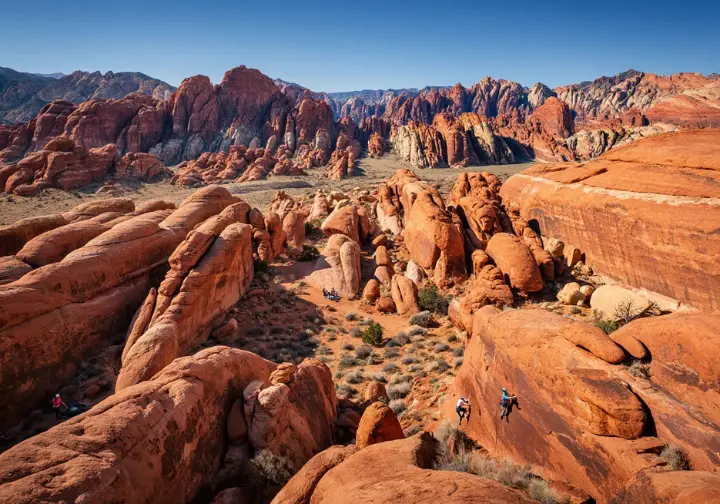
Red Rock Canyon stands as a premier global bouldering destination due to a combination of unique factors. The area’s distinct geological makeup, the sheer volume and variety of boulder problems, and the striking desert environment all contribute to its allure. Understanding these elements is key to appreciating and respecting this special place, a true gem for any boulderer. The red rock landscape is simply breathtaking.
The Allure of Aztec Sandstone
The defining characteristic of Red Rocks climbing is the Aztec Sandstone. This rock, formed from ancient sand dunes, results in unique and varied climbing features, from smooth slopers to sharp crimps and perfect patina. Climbers adore Aztec Sandstone for its excellent friction when dry, allowing for incredible smearing and trust in delicate foot placements. However, it’s crucial to understand its extreme fragility when wet; this is a cornerstone of sandstone care and essential for sandstone bouldering. For more on the geological makeup of Red Rock Canyon, you can explore further details.
The visual diversity of the sandstone is stunning, with vibrant reds, oranges, and yellows, alongside darker, harder varnished rock often found on more exposed faces. These variations can sometimes indicate differences in rock quality or climbing style. The nature of the rock often dictates a certain approach, requiring strong fingers, precise footwork, and good body tension. This makes it an excellent training ground for technical proficiency. Learning about the characteristics of Aztec sandstone will deepen your appreciation. The unique geology of Red Rock Canyon offers a rich tapestry for climbers to explore, with incredible rock formations at every turn. This quality sandstone is a dream for many.
A Landscape of Endless Problems
Red Rocks offers an immense scale of bouldering, with thousands of established boulder problems catering to every skill level, from V0 beginner routes to V16+ test pieces on various boulders. This sheer volume means climbers can visit repeatedly and always find new challenges. An overview of Red Rock bouldering areas showcases this breadth, often detailed on Mountain Project. The variety of bouldering styles is impressive, including slabs, overhangs, traverses, highballs, and technical faces. What kind of boulder problems do you find most engaging on these rocks?
This diversity keeps the climbing interesting and allows individuals to find problems that suit their strengths or push their weaknesses. While new boulder problems and areas are continuously developed, it’s important to respect established routes and local ethics regarding new routing. This dynamic nature is part of what makes the destination exciting. The aesthetic appeal of the boulders themselves and their settings within the dramatic desert landscape, sometimes near a ridge or hillside, adds to the overall experience, making Red Rocks a visually stunning place to climb. For more detailed coverage, the Red Rocks digital guidebook coverage on KAYA is a valuable resource. A better grasp of understanding boulder problems can enhance your appreciation of this landscape and its many test-piece boulders. Tackling your first boulder here is an unforgettable experience bouldering.
Understanding the Red Rocks Environment
The Red Rock Canyon National Conservation Area (RRCNCA) is a unique desert ecosystem. It hosts typical flora and fauna, and minimizing impact on this sensitive environment is paramount. This sets the stage for later discussions on Leave No Trace. Typical weather patterns include hot summers and cooler, more climbable conditions in fall, winter, and spring. Flash floods are a possibility in the canyons, so awareness of weather forecasts is important. The elevation changes can also affect conditions.
RRCNCA is a protected area managed by the Bureau of Land Management (BLM). Access is a privilege, accompanied by responsibilities and regulations climbers must follow. You can find Red Rock Canyon National Conservation Area details on the BLM website; this is key for understanding Red Rock conservation efforts. The area also holds cultural significance, with potential archaeological sites or petroglyphs, perhaps even in a cave. Respecting these resources by avoiding climbing on or near them is essential. Insights from bouldering in a desert environment like Joshua Tree can offer transferable knowledge for any climbing trip.
Navigating Red Rocks: Key Bouldering Areas
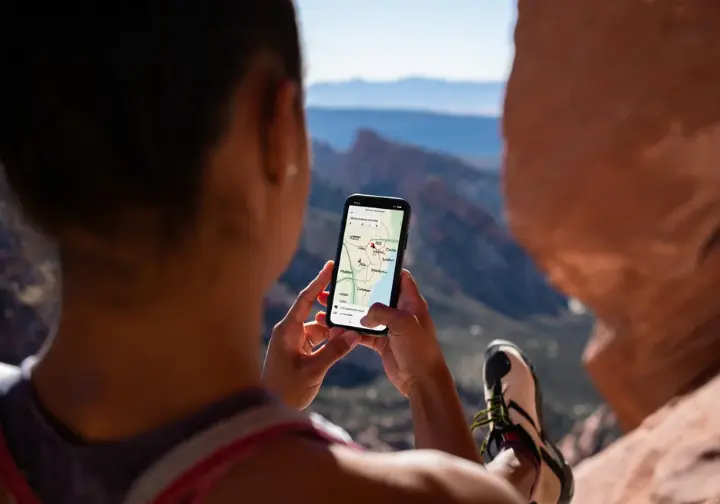
This section provides an insider’s look at the primary bouldering destinations within Red Rock Canyon. We’ll break down the characteristics, access, and must-know details for Kraft Boulders, Calico Basin, and briefly touch upon other zones for those seeking more adventure. These are among the most popular Red Rocks bouldering areas, each a significant climbing area.
Kraft Boulders (Calico Hills): The Main Event
Kraft Boulders is arguably the most popular and accessible bouldering area in Red Rocks, known for its high concentration of problems across all grades. It’s located outside the Scenic Drive, meaning no timed entry is needed for Kraft itself. The typical approach involves parking, which can be very challenging on busy days, and navigating to main clusters like the Monkey Bar Boulder area or The Cube. For Kraft Boulders specific information, Mountain Project is a good resource. The sunny Kraft Boulders are a major draw.
Kraft is famous for classic moderate boulder problems, powerful overhangs, and some well-known test pieces. Insider tips for navigating Kraft include arriving early for parking, considering weekday visits to avoid crowds, or exploring slightly further afield boulders. Respecting private property boundaries is also very important. For those new to the area, considering some beginner climbing at Kraft Boulders can be a great start, perhaps on the Bathroom Boulder or Bathtub Boulder. This is prime Kraft mtn/bouldering.
Calico Basin: Variety and Classics
Calico Basin is another major bouldering hub, distinct from Kraft though geographically close. It encompasses areas like Red Spring, Ash Spring, and Kraft Wash, offering stunning scenery with vibrant red and white rock formations. Like Kraft, it’s generally outside the main Scenic Drive timed entry requirements but has its own parking areas that can fill up. Are you prepared for the vibrant colors of Calico and its many boulders? The Red Spring boulders are particularly noteworthy.
The area offers a diverse range of bouldering, from roadside classics to more secluded problems, with a good mix of grades and styles. Some sectors might present a slightly different character of rock or problems compared to Kraft. Well-known areas within Calico Basin include The Pearl boulder area or the Pork Chop Boulder, popular for their quality and aesthetics. You can find Calico Basin bouldering details through resources like KAYA, which often provide context for specific boulder problems and areas.
Beyond the Main Hubs: Exploring Other Zones
While Kraft and Calico are most frequented, Red Rocks offers numerous other bouldering opportunities for those willing to explore further. Areas like Black Velvet Canyon, Gateway Canyon, or spots along the Scenic Drive (requiring timed entry) like Pine Creek Canyon provide different experiences. For instance, Black Velvet Canyon is known for more adventurous bouldering, potentially longer canyon approaches, and some impressive highballs. An example of advanced bouldering in Black Velvet Canyon showcases its potential.
These alternative zones often provide a quieter experience and can be good options when main areas are crowded. However, they may require more effort for approach or navigation along a trail. Having a good guidebook or app (like the usual Mountain Project resource), and potentially more experience, is advisable when venturing into these less-traveled zones due to less obvious trails or boulder problem locations. Some climbs might involve a shallow dihedral or a tricky arete.
Essential Red Rocks Bouldering Logistics
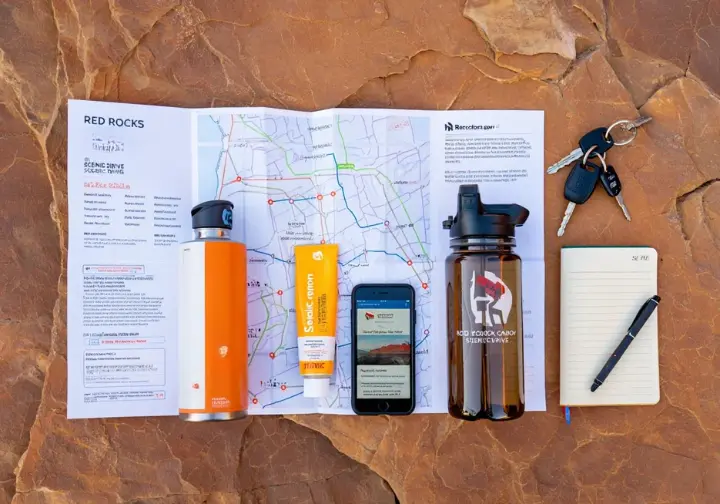
Planning is critical for a successful Red Rocks bouldering trip. This section covers the best times to visit, navigating access requirements like the Scenic Drive timed entry, parking intelligence, and options for accommodation and essential amenities near the mountain. Efficiently planning your bouldering Red Rocks trip starts here, perhaps even considering a stay at the Red Rock Casino for off-days, though most climbers opt for the Red Rock Campground.
Best Seasons for Your Trip
The prime bouldering seasons in Red Rocks are fall, winter, and spring. These periods typically offer cooler, more comfortable temperatures ideal for climbing on sandstone. Fall might have stable weather but can be busy. Winter can be cold but offer crisp conditions and fewer crowds. Spring brings pleasant temperatures but also potential for rain and more visitors. For insights on seasonal climbing conditions Red Rocks, local resources are helpful.
Bouldering in Red Rocks during peak summer (June-August) is strongly advised against due to extreme heat. This is uncomfortable, dangerous, and detrimental to the rock. Checking historical weather data and current forecasts when planning is important, as conditions vary. Familiarity with planning for desert climbing seasons can provide useful context for your climbing trip.
Access, Permits, and Getting Around
The Red Rock Canyon Scenic Drive timed entry system is typically in effect from October 1st to May 31st. Reservations are made via Recreation.gov, and fees are involved. This is crucial for accessing bouldering areas along the 13-mile loop. However, popular areas like Kraft Boulders and Calico Basin are generally outside the Scenic Drive and do not require this permit for direct access. You can verify Red Rock Scenic Drive timed entry details with the BLM.
Parking at popular trailheads is limited and lots fill early, especially on weekends and holidays. Legal parking is essential to avoid fines and maintain good relations. A rental car is necessary for accessing most bouldering areas from Las Vegas. General directions from the Strip or airport to the Red Rocks vicinity are straightforward. The main trail to many crags starts from these parking lots.
Accommodation and Amenities
Main accommodation options include staying in Las Vegas, with its vast range of hotels and rentals, or the Red Rock Canyon Campground (managed by BLM, reservations highly recommended). Vegas offers amenities but requires driving; camping is closer but with fewer comforts and books out quickly. Information on camping near Red Rock Canyon can often be found through local organizations.
Essential amenities include grocery stores, water sources (carry plenty into the desert), and climbing shops for last-minute needs. Leave No Trace principles related to camping, like proper waste disposal, are particularly important. How do you typically balance proximity to climbing with comfort when choosing accommodation for your hiking and climbing adventures? The location of your stay can significantly impact your experience bouldering.
Gear Up: What You Need for Red Rocks Bouldering
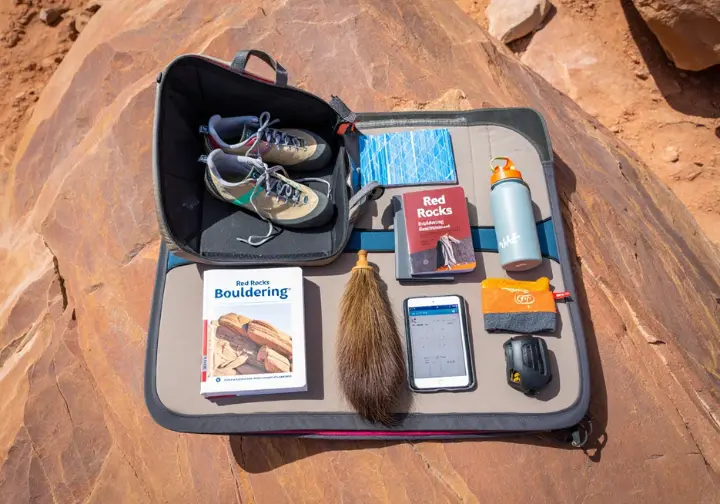
This section focuses on the essential equipment for safely and effectively enjoying bouldering in Red Rocks. We’ll cover non-negotiables like crash pads and appropriate footwear, discuss guidebook options, and list other crucial items for your desert climbing kit. Having the essential bouldering gear Red Rocks requires is key for tackling any boulder.
Crash Pads: Your Most Important Gear
Crash pads are absolutely essential for bouldering in Red Rocks, providing critical impact absorption. Landings can be rocky and uneven, making good padding crucial. Using multiple crash pads is common, especially for higher problems or tricky landing zones, allowing coverage of larger areas or gaps. Information on crash pad rentals Las Vegas is available through shops like Desert Rock Sports.
Basecamp Outdoor Gear also offers alternative crash pad rental options. Check current availability, pricing, and reservation policies. While different types of crash pads exist, the focus here is on their necessity and availability. When choosing the right crash pads, consider the types of boulder problems you’ll encounter. You can also deepen your understanding bouldering mat features for a well-rounded perspective. Make sure your chosen pad can handle a fall onto hard ground.
Choosing Your Guidebook: Digital vs. Physical
Primary guidebook options include digital apps like KAYA (partnered with Tom Moulin) and traditional physical guidebooks such as Tom Moulin’s “Southern Nevada Bouldering” series for Red Rock. Digital guides offer GPS, beta videos, and offline access. Cons include battery reliance. The KAYA Red Rocks digital guidebook is a popular choice for navigating to each boulder.
Physical guidebooks provide comprehensive maps and historical info, with no battery needed. Cons can be bulkiness and outdated information. Tom Moulin Southern Nevada Bouldering guidebook copies can sometimes be found on marketplaces. Climbers might choose based on preference or use both in conjunction: a physical book for big-picture planning and an app for on-the-ground navigation to specific boulders.
Other Essential Bouldering Gear
Other crucial items include appropriate climbing shoes suited for sandstone’s friction, emphasizing a good fit. Chalk (bag or bucket) for grip, a good quality boar’s hair brush for ethically cleaning holds from dirt and excess chalk, and climbing tape for fingers are also necessary. Consider reading about general climbing ethics and gear for broader context.
A durable backpack, plenty of water, sun protection (sunscreen, hat, sunglasses), and a basic first-aid kit are vital. Optional but useful items include a small tarp, headlamp, and layers for changing temperatures. Ensuring you are finding the right climbing shoe fit is paramount, as is selecting climbing chalk and bags that suit your needs for a day on the rocks.
Climbing Smart & Safe in Red Rocks
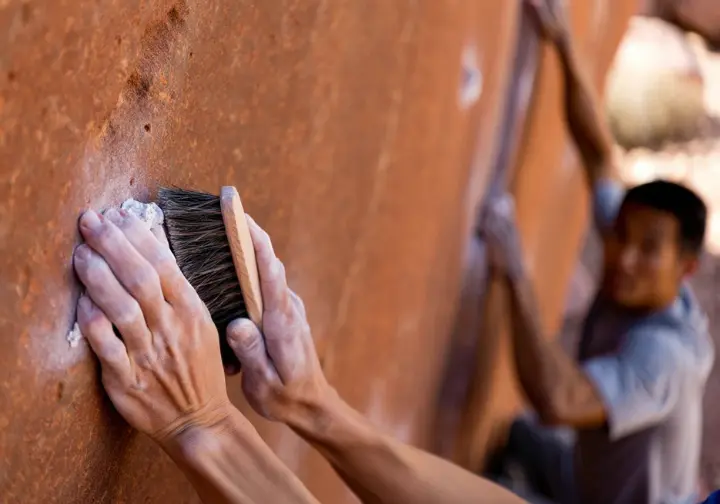
This crucial section focuses on the responsibilities of bouldering in a fragile desert environment. We’ll cover the non-negotiable rule about wet sandstone, Leave No Trace principles for climbers, and general desert safety awareness. Adherence to Red Rocks climbing safety and ethics is paramount for protecting the Red Rock conservation area.
The Cardinal Sin: Climbing on Wet Sandstone
Climbing on wet Aztec sandstone is strictly prohibited and the most significant ethical breach. Wet sandstone loses integrity, becoming extremely friable, leading to broken holds and permanently damaged routes. The dangers of climbing on wet rock are well-documented by the community. To determine if rock is too wet: if the ground is damp, the rock is damp. Look for visual cues on the stone. Sometimes suspect rock can look dry but be weak.
Even if the surface seems dry, moisture can persist. Recommended waiting times after rain are 24-72 hours, depending on rainfall, sun, and humidity; err on caution. Ignoring this rule causes permanent destruction and disapproval. Check local guide perspectives on wet sandstone for more insight. For a general overview, understanding fundamental climbing rules is a good start. A similar sandy fate can be avoided with patience.
Leave No Trace: Protecting Red Rocks
The seven Leave No Trace (LNT) principles apply specifically to bouldering in the desert environment of Red Rocks. Key actions: Pack it in, pack it out (ALL trash). Dispose of human waste properly (wag bags are essential; the SNCC sometimes provides them). Familiarize yourself with Leave No Trace principles for climbers for comprehensive guidance.
Stay on established trails to protect fragile desert vegetation and cryptobiotic soil. Minimize chalk use; brush off tick marks and excess chalk from holds. Respect wildlife (no feeding animals, be aware of snakes/scorpions). Be considerate of other visitors by managing noise and group size. Supporting local stewardship and climber responsibility through organizations like the Southern Nevada Climbers Coalition is also encouraged. This helps preserve the site for future ascents.
General Safety and Desert Awareness
Proper spotting techniques, good communication, and assessing landing zones are key bouldering safety practices. Desert-specific hazards include dehydration (drink ample water), heat exhaustion (especially in shoulder seasons), and flash floods (be aware of forecasts, especially in canyons or near a creek). For desert safety guidelines Red Rock, local resources can be invaluable.
Potential wildlife encounters include snakes, scorpions, or spiders; minimize risks by being aware of hand/foot placements. A basic first-aid kit, knowing emergency procedures, and reliable communication (cell service can be spotty) are recommended. Note emergency contact numbers. Reviewing essential bouldering safety practices will reinforce these points for every climber. Be mindful of the elevation and how it might affect you during a long hike to the crags.
Insider Tips: From V0 to V-Hard

This is where we share coveted “insider” knowledge. This section provides specific advice on understanding Red Rocks‘ unique climbing style and grades, offers curated lists of must-do boulder problems across various difficulty levels (V0-VHard), and shares tips for first-timers and local etiquette. These Red Rocks bouldering tips V0-VHard will enhance your experience on the solid rock.
Decoding Red Rocks Grades and Styles
The perception of bouldering grades in Red Rocks can vary; some find them stout. Grading is subjective, but a general consensus often exists. Predominant climbing styles include technical footwork, body positioning, powerful overhangs, friction-dependent slopers, and sharp crimps on varnished faces. For a general idea of understanding Red Rocks climbing style, online forums and area descriptions can be useful. Some climbs might feature a difficult mantle or require navigating a thin arete.
For those new to sandstone or Red Rocks, trust your feet, use subtle body movements, and approach insecure-feeling problems methodically. Different areas or even different boulders can have distinct rock characteristics or styles, encouraging exploration and adaptation. General advice on improving bouldering technique for varied styles is always beneficial. Some technical climbs demand precise use of every edge.
Must-Do Boulders: V0-V2 & V3-V5
For beginners or warm-ups (V0-V2), consider classics like Plumber’s Crack (V1, Kraft) for a fun introduction, or The Turl (V0, Kraft) for its interesting features. The Potato Chips boulder (V2, Kraft) is another popular choice; some call it the Potato Chip Boulder. Many popular V0-V5 Red Rocks boulder problems are documented in digital guidebooks. These are great first boulders for many.
For intermediate climbers (V3-V5), The Pearl (V4, Calico Basin – often cited as V4 or V5) is a benchmark for its aesthetic line on the Pearl boulder. Pork Chop (V3, Calico Basin) offers satisfying movement. Monkey Bar Direct (V4, Kraft) is a powerful classic. These are suggestions; guidebooks list many more moderate boulder problems. An insider tip: explore slightly less-trafficked clusters for hidden gems in these grades. Applying beginner bouldering problem strategies can help tackle these grades. The Chip Boulder is another one to look for.
Stepping Up: V6-V9 & V-Hard Classics
For advanced climbers (V6-V9), Angel Dyno (V7, Kraft) showcases dynamic movement. Fear of a Black Hat (V9, Kraft) is a well-known test piece. The Fountainhead (V9, Kraft) is another sought-after classic. For those seeking the hardest challenges, Red Rocks boasts iconic hard boulder problems Red Rocks like Sleepwalker (V16) and The Nest (V15), highlighting the area’s world-class status. These often involve thin slopers or a crimpy ledge.
These are selective examples; the depth of hard climbing in Red Rocks is extensive. An insider tip for harder climbs: specific conditions (cool, dry air) can be crucial for success on friction-dependent problems, especially those with a squat start or requiring a powerful move to a big overhanging ledge. Strong finger strength and body tension are particularly beneficial for these test-piece boulders. Good climbers will find plenty to challenge them.
First-Timer Tips and Local Etiquette
For first-timers: reiterate hydration, start conservatively with grades, and prepare for the desert and its sunny conditions. Local etiquette beyond LNT includes managing noise at the crag, being mindful of group size at popular boulders, sharing pads if agreed upon, and yielding to those working a problem. Understanding Southern Nevada climbing community ethics is key. What’s one piece of etiquette you always try to follow when at the top of a boulder after a send, or when approaching a cave opening that might be a climb?
The Southern Nevada Climbers Coalition (SNCC) is vital for access and stewardship; consider supporting them. Also, be aware of national climbing access and advocacy groups like the Access Fund. A final tip: embrace the unique landscape and connect respectfully with the local community. Reviewing general rock climbing etiquette provides a good foundation. Be mindful when you down climb or navigate a steep face. Even a dirt bag boulderer respects the local scene. The incredible rock here deserves it. Some Nevada find rock areas are truly special.
Conclusion: Your Red Rocks Bouldering Adventure Awaits
Red Rock Canyon offers unparalleled and diverse bouldering, from beginner circuits on several boulders to world-class hard problems, all in a stunning desert landscape. Approaching Red Rocks with profound respect for its fragile Aztec sandstone is critical, especially by never climbing on wet rock and diligently practicing Leave No Trace principles. We encourage you to use the guidance here to plan a successful, enjoyable, and responsible trip. This contributes to preserving this cherished climbing area with its great rock. Embrace the challenge, beauty, and unique character of Red Rocks bouldering. This fosters personal skill development and a deeper appreciation for sustainable outdoor recreation. Our aim is to be a comprehensive resource, empowering dedicated climbers to explore responsibly and elevate their understanding of the sport and its environments, from the canyon entrance to the highest peak.
Frequently Asked Questions about Bouldering Red Rocks
What is the absolute best time of year to go bouldering in Red Rocks? >
I’m a beginner (V0-V2). Are Kraft Boulders or Calico Basin better for me? >
How many crash pads do I really need for Red Rocks? >
If it rains, what are my bouldering options besides waiting for the sandstone to dry? >
We are a participant in the Amazon Services LLC Associates Program, an affiliate advertising program designed to provide a means for sites to earn advertising fees by advertising and linking to Amazon.com. As an Amazon Associate I earn from qualifying purchases. We also participate in other affiliate programs. The information provided on this website is provided for entertainment purposes only. We make no representations or warranties of any kind, expressed or implied, about the completeness, accuracy, adequacy, legality, usefulness, reliability, suitability, or availability of the information, or about anything else. Any reliance you place on the information is therefore strictly at your own risk. Additional terms are found in the terms of service.



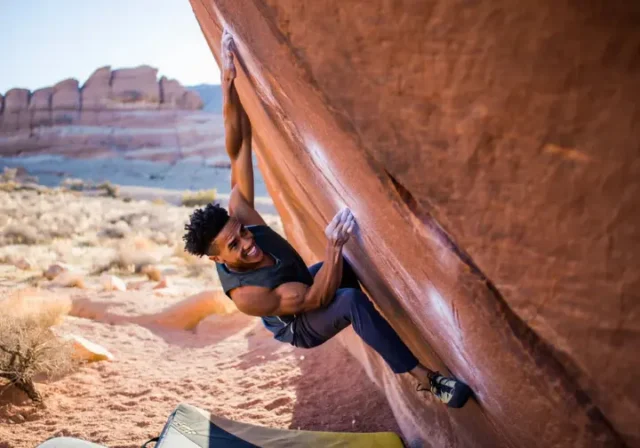


![Boise Idaho Rock Climbing: Crags, Gyms & Beta [Guide] Boise Idaho rock climbing guide: diverse female climber topping out at The Black Cliffs, showcasing crags, gyms, and beta.](https://rockclimbingrealms.com/wp-content/uploads/2025/03/01-boise-idaho-rock-climbing-crags-gyms-beta-guide-238x178.webp)




